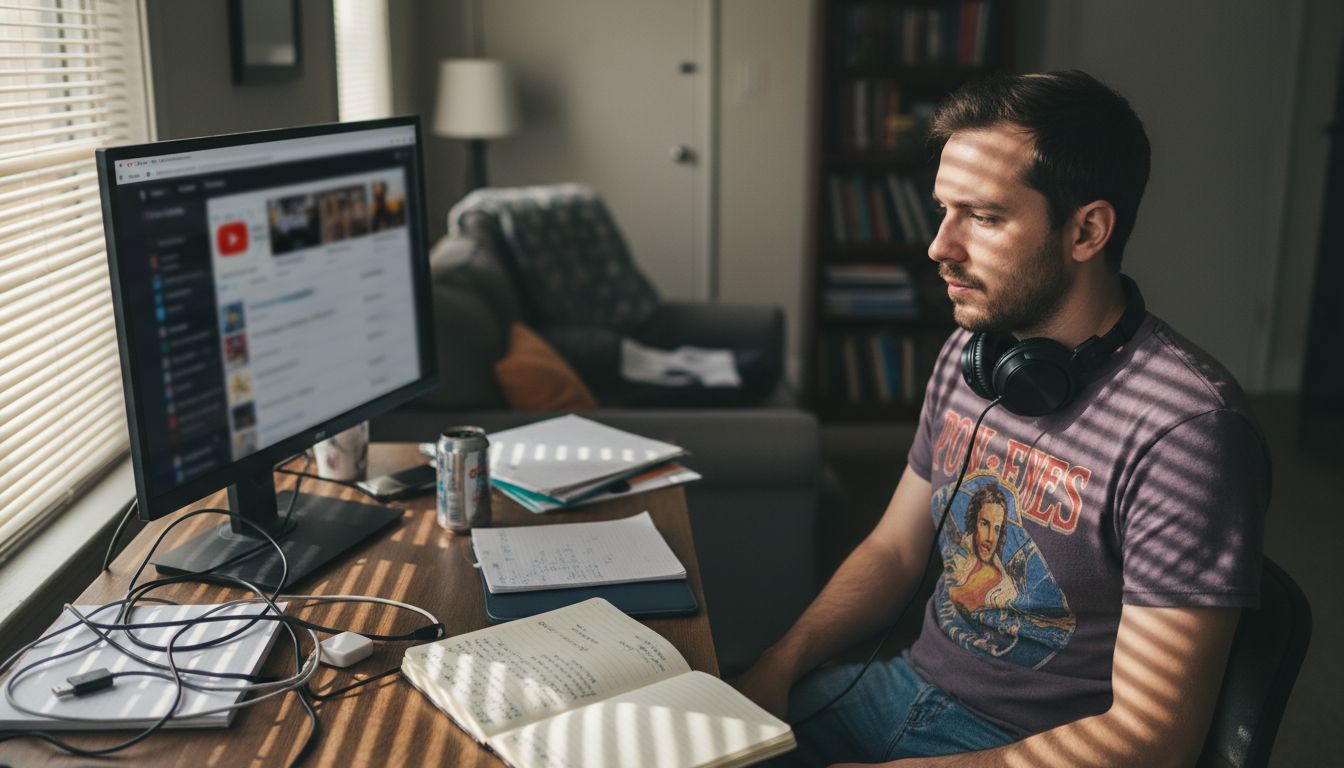Automated Note-Taking Explained: Efficient Strategies and Tools
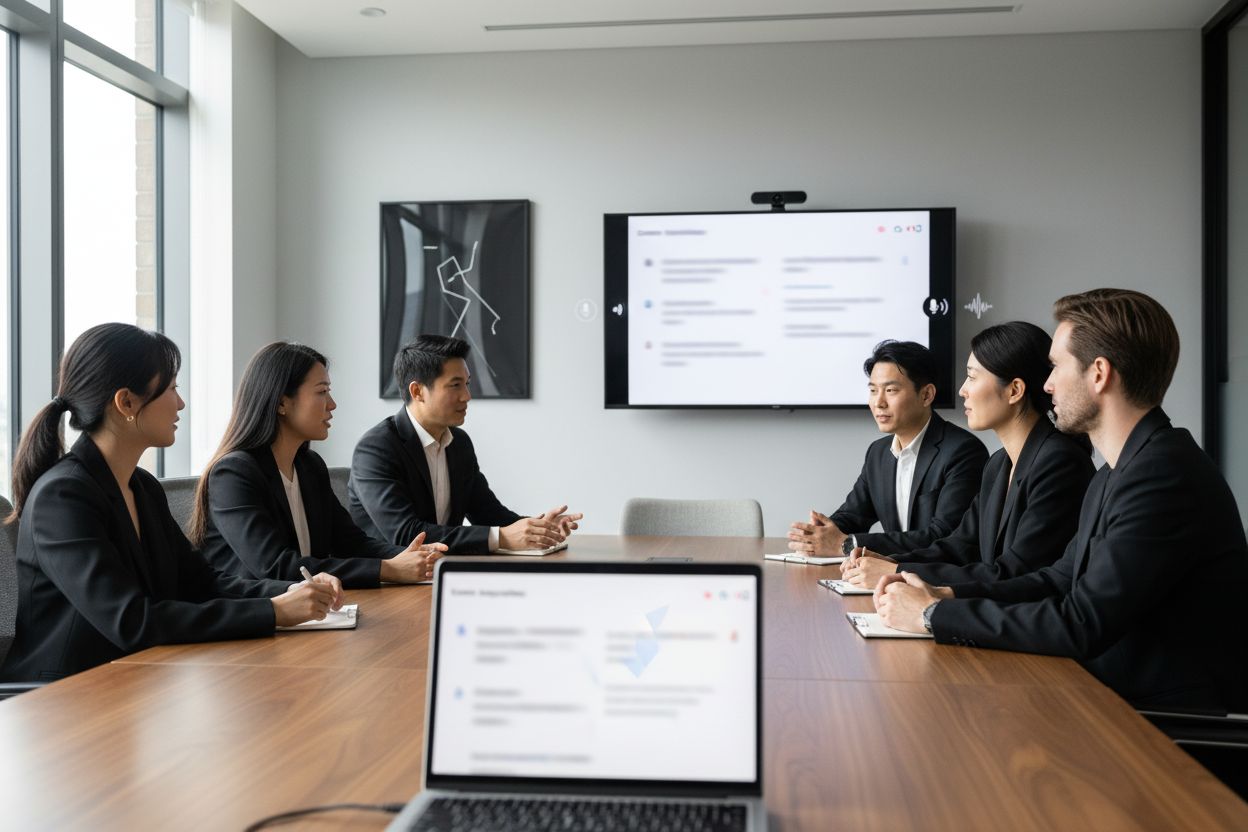
Over 75 percent of professionals admit they forget key meeting details within days without written notes. As digital information expands across audio, video, and text, keeping up with important points feels tougher than ever. Automated note-taking technology is reshaping how people save and remember information by quickly turning complex content into organized, searchable summaries that fit today’s fast-paced work and learning environments.
Table of Contents
- What Is Automated Note-Taking Technology?
- Types of Automated Note-Taking Solutions
- How Automated Note-Taking Systems Work
- Top Use Cases Across Professional Settings
- Privacy, Data Security, and Compliance Issues
- Comparing Manual vs. Automated Note-Taking
Key Takeaways
| Point | Details |
|---|---|
| Automated Note-Taking Technology | Utilizes AI and NLP to efficiently capture and organize information from diverse digital sources, enhancing productivity. |
| Types of Solutions | Includes text-based tools, audio/video transcription, and real-time meeting systems, catering to various professional needs. |
| Privacy and Compliance | Requires careful management of data security and participant consent, particularly in sensitive industries like healthcare and legal. |
| Manual vs Automated | Automated systems vastly outperform manual note-taking in speed, accuracy, and organization, leading to improved information retention. |
What Is Automated Note-Taking Technology?
Automated note-taking technology represents a transformative approach to capturing, processing, and organizing information using advanced artificial intelligence and machine learning algorithms. At its core, this technology enables users to automatically extract key insights, summarize content, and generate structured notes from various digital sources like videos, audio recordings, webinars, lectures, and text documents.
The fundamental mechanism involves sophisticated natural language processing (NLP) algorithms that can identify and extract meaningful content. These intelligent systems analyze speech, text, and multimedia inputs to recognize critical information patterns, key concepts, speaker intentions, and contextual relevance. By employing advanced techniques like semantic analysis, machine learning, and intelligent parsing, automated note-taking tools can transform raw information into concise, digestible summaries.
Key features of automated note-taking technology typically include:
- Automatic transcription of spoken content
- Real-time summarization capabilities
- Intelligent keyword and concept extraction
- Multilingual support
- Contextual understanding beyond simple word-for-word translation
When it comes to practical applications, understanding the advantages of automated content summaries can help professionals and students alike leverage these powerful technologies for enhanced learning and productivity. By reducing manual note-taking effort and increasing information retention, automated note-taking represents a significant leap forward in how we consume and process digital information.
Types of Automated Note-Taking Solutions
Automated note-taking solutions have evolved into diverse categories, each designed to address specific user needs and information capture scenarios. These technologies range from AI-powered transcription tools to intelligent summarization platforms, offering professionals and students powerful ways to streamline information processing and knowledge management.
Text-Based Automated Note-Taking Solutions focus on converting written or digital content into structured notes. These tools can analyze documents, PDFs, web articles, and text-heavy materials, extracting key insights, generating summaries, and creating structured outlines. They leverage advanced natural language processing to identify central themes, critical points, and contextual relationships within complex textual content.
Audio and Video Transcription Tools represent another sophisticated category of automated note-taking technology. These solutions can transform spoken content from lectures, podcasts, webinars, and meetings into accurate, searchable text. Exploring the latest AI summarization tools reveals how these technologies can not only transcribe but also generate concise summaries and highlight key discussion points.
Key types of automated note-taking solutions include:
Here’s a high-level summary of the main types of automated note-taking solutions:
| Solution Type | Main Function | Typical Use Cases |
|---|---|---|
| Text-Based Tools | Summarize & outline text | Research papers PDFs Articles |
| Audio/Video Transcription | Convert speech to text | Meetings Lectures Podcasts |
| Screen Capture & Annotation | Record visuals & notes | Webinars Presentations Tutorials |
| Real-Time Meeting Transcription | Live multi-speaker capture | Business calls Team meetings |
| Academic Summarization | Condense educational content | Lectures Seminars Courses |
| Cross-Platform Sync | Accessible notes everywhere | Mobile users Remote teams |
- Screen capture and annotation tools
- Real-time meeting transcription platforms
- Academic lecture summarization software
- Multimedia content extraction systems
- Cross-platform note synchronization services
The ultimate goal of these diverse solutions is to reduce manual information processing, enhance learning efficiency, and help users focus on understanding and applying knowledge rather than getting bogged down in extensive note-taking tasks.
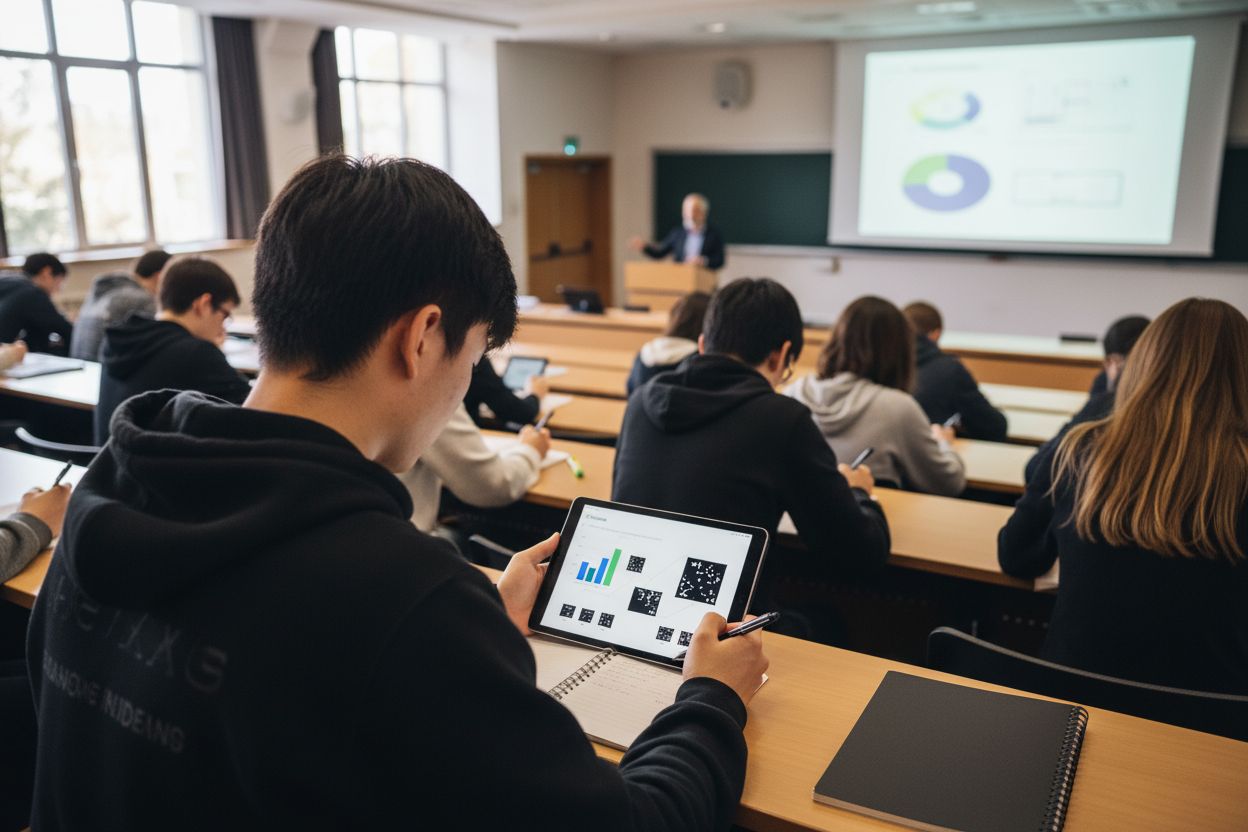
How Automated Note-Taking Systems Work
Automated note-taking systems employ sophisticated artificial intelligence (AI) and machine learning (ML) technologies to transform raw information into structured, meaningful notes. These intelligent systems follow a complex multi-stage process that involves capturing, analyzing, processing, and organizing digital content from various sources such as audio, video, text documents, and live presentations.
The initial stage involves input processing, where the system uses advanced speech recognition and optical character recognition (OCR) technologies to convert spoken words or written text into machine-readable digital format. This involves breaking down audio or visual inputs into discrete linguistic units, identifying speech patterns, and translating them into accurate textual representations. Understanding why choose AI summarizers for efficiency highlights how these technologies can rapidly process complex information streams with remarkable accuracy.
Next, the system employs natural language processing (NLP) algorithms to extract meaningful content. These intelligent algorithms analyze the converted text by:
- Identifying key concepts and themes
- Recognizing contextual relationships
- Filtering out redundant or less important information
- Generating concise, coherent summaries
- Preserving the original semantic meaning
The final stage involves intelligent organization, where the system structures the extracted information into logical, easily navigable notes. This might include creating hierarchical outlines, highlighting critical points, generating tags, and ensuring the notes are searchable and easily retrievable for future reference.
Top Use Cases Across Professional Settings
Automated note-taking technologies have revolutionized documentation and information management across diverse professional landscapes, offering tailored solutions that address unique communication and record-keeping challenges in different industries. These intelligent systems are no longer one-size-fits-all tools, but sophisticated platforms designed to enhance productivity and accuracy in specific professional contexts.
In sales and customer success environments, automated note-taking platforms like Avoma have become instrumental in capturing crucial meeting details and seamlessly integrating them with customer relationship management (CRM) systems. Understanding the advantages of automated content summaries reveals how these tools can transform client interaction documentation, ensuring no critical information slips through the cracks.
According to research from F6S, specialized automated note-taking solutions are emerging across unique professional domains:
- Sales teams using CRM-linked meeting transcription tools
- Therapists utilizing HIPAA-compliant documentation platforms
- Healthcare professionals capturing patient consultation details
- Academic researchers documenting research interviews
- Legal professionals recording and summarizing depositions
- Beekeepers employing voice-guided data capture systems
The core value proposition remains consistent across these diverse applications: reducing manual documentation time, improving information retention, and creating searchable, structured records that can be easily referenced, shared, and analyzed. By leveraging artificial intelligence and advanced natural language processing, these tools are transforming how professionals across industries capture, process, and utilize critical information.
Privacy, Data Security, and Compliance Issues
Automated note-taking technologies introduce complex privacy and data security challenges that demand careful navigation across professional and personal contexts. These powerful tools, while incredibly useful, raise significant ethical considerations about consent, data ownership, and potential misuse of sensitive information captured during recordings.
The primary privacy concerns stem from the potential for unauthorized or undisclosed recording of conversations. Understanding why automate video summaries matters underscores the importance of transparent communication and explicit consent when implementing automated note-taking systems. Professionals must establish clear protocols that ensure all participants are aware of and agree to being recorded.
Key privacy and compliance considerations include:
- Obtaining explicit participant consent before recording
- Implementing robust data encryption protocols
- Providing clear opt-out mechanisms
- Establishing strict access controls
- Ensuring compliance with industry-specific regulations (HIPAA, GDPR)
- Protecting against potential AI-generated misinformation or ‘hallucinations’
Moreover, different industries require nuanced approaches to data management. Healthcare and legal sectors demand the highest levels of confidentiality, requiring specialized automated note-taking solutions that meet stringent regulatory standards. The challenge lies not just in capturing information, but in doing so ethically, securely, and with full respect for individual privacy rights.
Comparing Manual vs. Automated Note-Taking
The landscape of note-taking has dramatically transformed with the emergence of artificial intelligence technologies, creating a stark contrast between traditional manual methods and cutting-edge automated solutions. While manual note-taking relies on human interpretation and real-time cognitive processing, automated systems leverage advanced algorithms to capture, analyze, and synthesize information with unprecedented speed and accuracy.
Manual note-taking demands significant cognitive effort, requiring individuals to simultaneously listen, comprehend, filter, and record critical information. This approach is inherently limited by human attention span, writing speed, and personal biases. Understanding efficient note-taking guide for better learning highlights the cognitive challenges professionals and students face when attempting to capture comprehensive notes manually.
Key differences between manual and automated note-taking include:
- Speed of information capture
- Accuracy of content retention
- Ability to process multiple information streams
- Consistency in documentation
- Searchability and organization of notes
- Potential for real-time translation and multilingual support
Automated note-taking systems represent a quantum leap in information management. They eliminate human error, provide instant searchability, and can process information across multiple formats simultaneously. Unlike manual methods, these intelligent systems can generate structured summaries, extract key insights, and create interconnected knowledge repositories that adapt and evolve with each interaction.
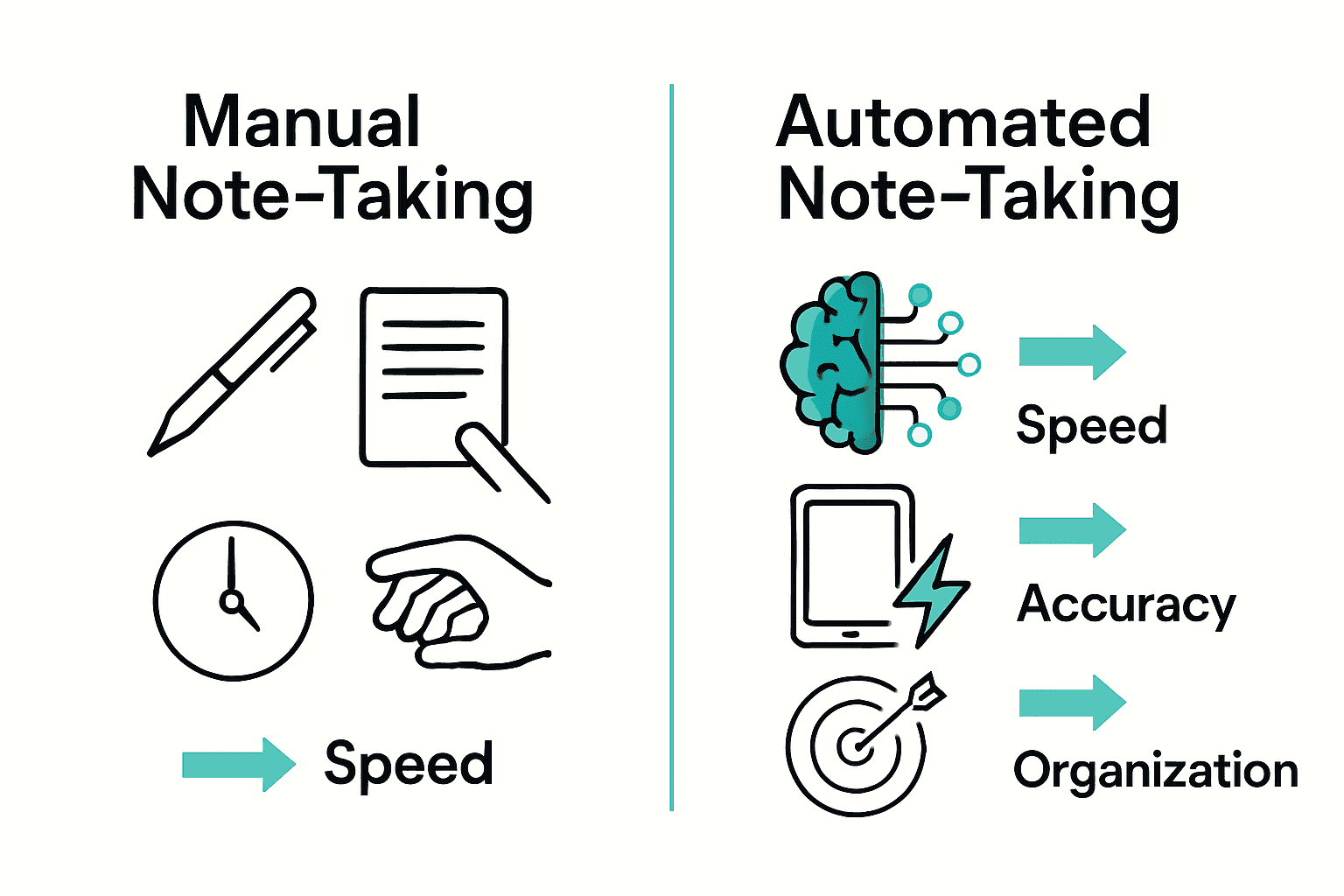
Unlock the Full Potential of Automated Note-Taking with SummYT
The article highlights the challenges of manual note-taking like missing key information and spending too much time capturing details. If you struggle to keep up with video lectures, webinars, or lengthy talks, you know how frustrating it is to lose focus or miss insights. Automated note-taking solutions that rely on AI and natural language processing can transform this process by creating clear, concise summaries and extracting key points automatically.
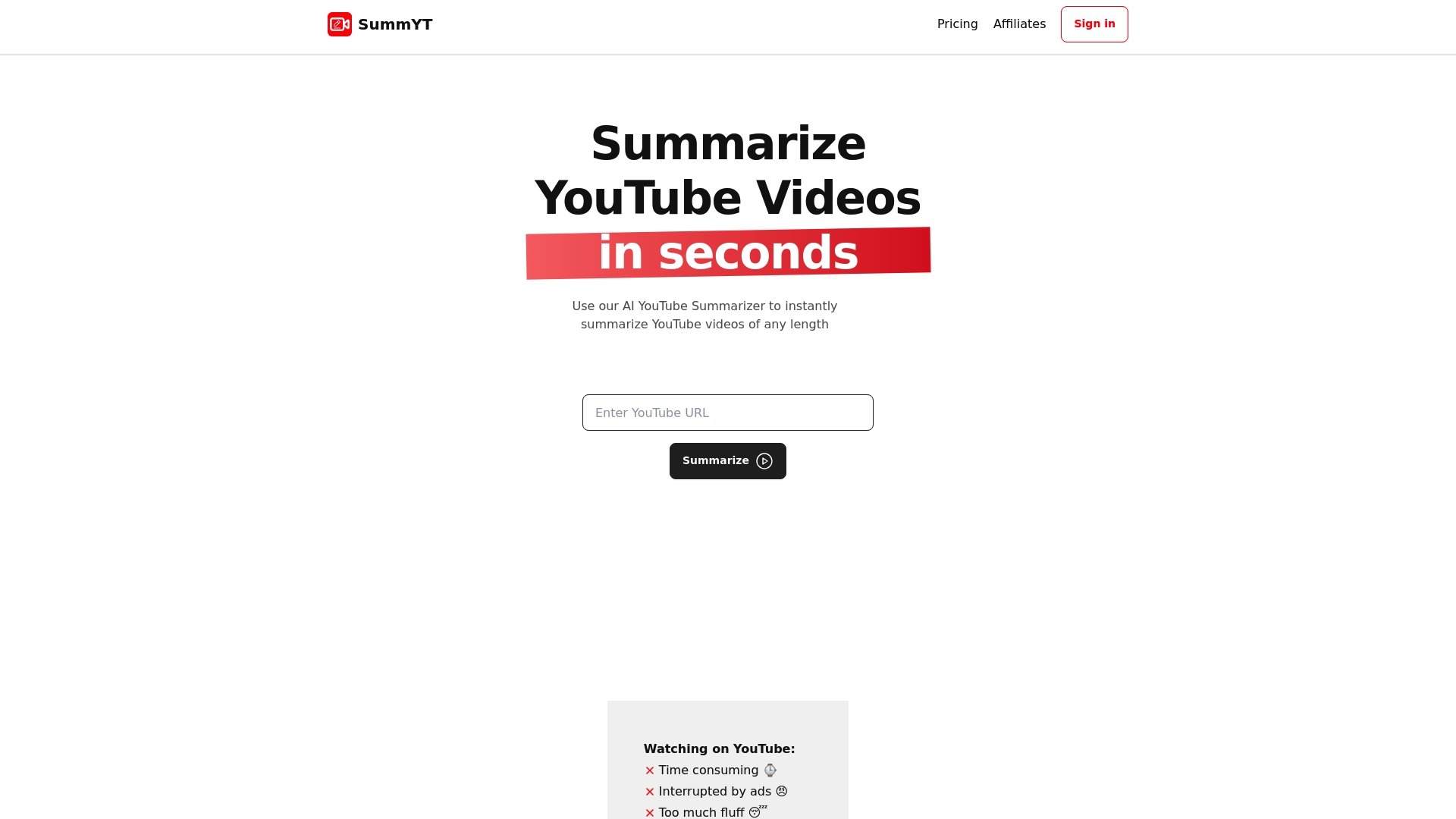
Experience these benefits firsthand with SummYT, the AI-powered YouTube summarizer designed to streamline video-based learning and boost productivity. Whether you are a student, professional, or lifelong learner, SummYT saves you time by turning any YouTube lecture, tutorial, or webinar into easy-to-digest notes. Check out how our platform provides unlimited summaries, supports multiple languages, and fits perfectly into your daily workflow by visiting SummYT main page. Explore the advantages of automated content summaries to understand why embracing AI summarization tools is critical today. Ready to reclaim hours of your day and never miss a key insight again Use SummYT now and transform the way you engage with video content.
Frequently Asked Questions
What is automated note-taking technology?
Automated note-taking technology uses artificial intelligence and machine learning to capture, process, and organize information from various sources, such as audio recordings and text documents, providing users with structured notes and summaries.
How do automated note-taking systems work?
These systems utilize speech recognition and natural language processing algorithms to convert audio or text inputs into machine-readable formats. They analyze this data to extract key concepts, summarize information, and organize it into structured notes.
What are the main types of automated note-taking solutions?
The main types include text-based tools for summarizing written content, audio/video transcription tools that convert speech to text, real-time meeting transcription platforms for live events, and academic summarization software for educational content.
What are the privacy concerns associated with automated note-taking tools?
Privacy concerns include the need for explicit consent from participants before recording, implementing strong data encryption, ensuring compliance with regulations like HIPAA and GDPR, and protecting sensitive information captured during the note-taking process.

